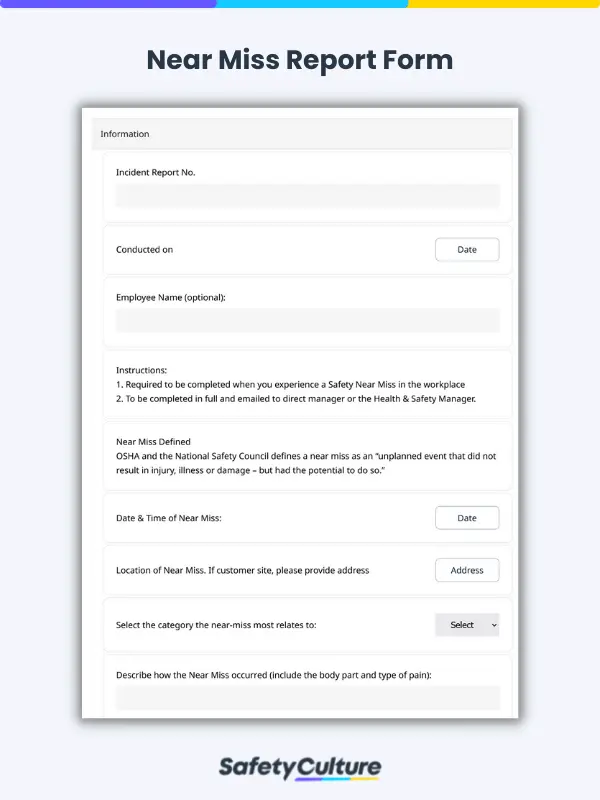What is a Near Miss Report Form?
A near-miss form or near-miss report form is used to document detailed statements of near miss events which could have resulted in injury or property damage. It is used by safety officers to record the details of near miss events so that risks can be mitigated and more serious, even fatal, incidents can be prevented.
What is a Near Miss Report?
A near-miss report is a type of incident report that formally records a near-miss event. The employee affected by this event types or fills out the near-miss report and submits it to their supervisor or to the safety officer on-site.
What Should it Include?
Near miss reports should contain the following:
- Date, time, and location of the near-miss event
- Hazard/s that triggered the near-miss event
- Description of how the near miss event occurred
- Possible consequences avoided
- Signature/s of the employee/s affected
Near Miss Reporting Example
Near miss reporting is essential in every industry, especially those that put employees at high risk of injury. It also raises organizational awareness of the hazards and risks that employees face and deal with every day.
For example:
An employee uses a ladder to fix a leak on a roof. While on the 4th step/rung of the ladder, his/her foot slips, but he/she manages to regain balance and no accident occurs.
Following the submission of the near-miss report, the ladder was inspected and it was found that a step grip was missing. This issue was immediately corrected, preventing other employees from getting into similar incidents.
The example above shows how important near-miss reporting is to workplace safety. If the employee who experienced the near miss chose to not report it, the ladder might have not been inspected and the issue with the step grip would have not been discovered and resolved. The missing step grip would then cause another employee to slip and he/she may not be as lucky as the first employee, leading to him/her getting injured.
OSHA Near Miss Examples
The following near-miss examples are based on two of the most frequently cited OSHA standards, hazard communication, and scaffolding safety.
OSHA Near Miss Example 1: An employee was about to use a dangerous chemical due to it being incorrectly labeled as safe. However, another employee recognized the dangerous chemical and stopped the first employee from using it just in time.
OSHA Near Miss Example 2: An employee working on a scaffolding suddenly feels a sharp pain in the knee. This pain caused the employee to stumble and nearly fall over but was able to use the scaffolding railing as support.
The examples above show that near misses can occur in a variety of situations. The hazard communication example shows that something as simple as labeling can lead to potentially life-threatening events. Meanwhile, the scaffolding safety example shows that near misses can be caused by unexpected hazards or factors not even related to the work itself.
Some of the other common near-miss examples in the workplace include instances such as:
- A worker almost slips and falls due to a wet floor, but manages to catch themselves at the last moment
- An employee is about to enter a hazardous area without the proper safety gear but is reminded by a coworker before doing so
- A container holding harmful chemicals almost spill due to improper handling but is safely caught before any damage occurs
- An equipment malfunctions and almost causes an injury, but the operator is able to stop it before anyone is hurt
- A forklift operator almost collides with a pedestrian but is able to brake in time
Tips for Encouraging Near Miss Reporting
Though near-miss reporting has many benefits, some employees may be hesitant to report near-misses because they are afraid of being reprimanded by their supervisors. Another reason why employees don’t report near misses is that these incidents can seem insignificant, especially when compared to accidents resulting in serious injuries.
Employees might also not report near misses simply because it’s inconvenient or they’re too busy with other work-related tasks and don’t have the time. To combat these blockers and promote a healthy near-miss reporting culture, safety officers can use the following tips:
Tip #1 Don’t Blame Employees
Communicate that reporting a near miss will not lead to the employee being blamed for it. This is best achieved by putting it into practice. When an employee reports a near miss, focus on the solution or what you, as the safety officer, can do to help that employee. You can still inform them if their actions or behavior were found to have caused the near miss but do so neutrally and logically.
Tip #2 Emphasize the Benefits
Communicate that near-miss reporting is crucial to their safety. Cite real-life examples, either from the news or from experience. While these examples should ideally focus on the positive effect a near-miss report had on the safety of employees, if necessary, you can discuss how an accident could have been prevented if the near-miss preceding it was reported.
Tip #3 Make Near Miss Reporting Easy
Provide employees with digital near-miss report forms that are easy to fill out. Paper near-miss report forms take more time and effort to complete and once submitted, they may even be misplaced. Digital near-miss report forms, on the other hand, take up less time, effort, and storage. They can also be completed on a mobile device for on-the-go reporting.
Near Miss Report Example
It’s convenient to have a report form ready when a near-miss event happens. A near-miss report form contains information such as the date and time of the near-miss event and the names of the employees who were present. Other data that help recollect and record the event are the location and other important details of the incident. Check out our digital near-miss report form which is ready-to-use and customizable according to your specific needs.


